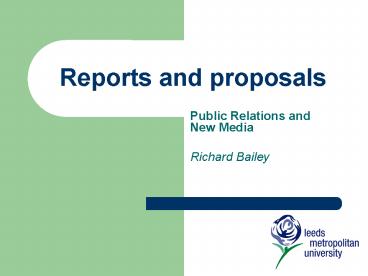Reports and proposals PowerPoint PPT Presentation
Title: Reports and proposals
1
Reports and proposals
- Public Relations and New Media
- Richard Bailey
2
Reports or proposals?
- Reports look back on something that has happened
and provide analysis - What has happened? Does it matter?
- Proposals start with problem diagnosis and
recommend a solution (forward-looking) - Whats the problem? What should we do about it?
3
Your assignments
- 2,500 word report applying critical thinking to
contemporary corporate communications challenges
faced by an international organisation of the
students choice in the context of new media
developments (weighted 60). - 1,500 word proposal written for the same
organisation covering possible strategies and
tactics to address their challenges in the
digital environment (weighted 40).
4
What is a report?
- A formal business document
- Information on a situation
- Recommendations on future action
- Based on fact
- You must distinguish between facts and opinions
- Need to provide evidence of research reading
5
Report structure
- Title
- Table of contents
- Executive summary (write this last)
- Introduction (terms of reference, background)
- Facts
- Analysis and discussion of factual material
- Conclusions
- Recommendations
- Appendices
- References
6
Structure
- Use headings for sections
- You can use section numbers
- 1. Section title
- 1.1 Sub-section
- 1.2 Sub-section
- Use consistent headings/numbering
7
Executive summary
- Write this at the end
- It is a one page summary of the whole report,
including any conclusions and recommendations - Helps the reader decide whether to read full
report
8
Introduction
- Set out the terms of reference for the report
(who is writing it, and why, and what is its
scope) - Provide any background information the reader
might require - Statement of problem
- History of events leading to this situation
- An account of the methods used to gather
information
9
Body of report
- Should contain the factual information gathered
- Break down blocks of text with tables and lists
- Headings and sub-headings help to break up the
page and make it readable - Remove over-detailed information to an appendix
10
Conclusions, recommendations
- Even if these are covered in the body of the
report, they should be gathered again at the end
(and summarised up front in the executive
summary) - If recommendations are required, they should be
in a separate section
11
Appendices, references
- Appendices should contain background data or
complex information - Appendices do not count towards word limit
- References demonstrate authority, credibility and
professional practice - Name of author or authors
- Year of publication / edition and publication
date - Full title
- Place of publication and name of publisher
12
Style
- A report is factual, mostly objective
- Formal language preferable
- Spelling and punctuation matter (you will be
judged on this) - Should be comprehensible if read in isolation
13
What is a proposal?
- A proposal is a persuasive document
- Looks to the future (reports are
backward-looking) - Proposes a plan of action
- Seeks agreement
14
Structuring a PR proposal
- Executive summary
- Situation analysis
- Problem statement
- Campaign goal
- Audience identification and messages
- Strategies
- Communication tactics
- Timescale
- Budget
- Evaluation plans
15
Executive summary
- The Problem State here what you believe the
problem to be. - Programme Goal State here what your ultimate
goal is. - Target Audiences (1) Your primary audience, (2)
your secondary (intervening) audience(s), and (3)
your tertiary (special) audience(s). - Major Strategy State your major strategy here,
listing the key tactics that you will use in your
campaign. - Recommended Budget State your total anticipated
income and sources, your anticipated expenses,
and the anticipated net profit or loss. - Evaluation Plans State how you expect to
evaluate (and expect to know) whether or not
you've achieved each of your campaign and
audience objectives
16
Problem statement
- The problem statement itself should be concise
and very specific. If possible, write it in 25
words or less, using standard subject-verb-object
order. This step is crucial to your plan and to
the success of your campaign. Mess up here and
you will end up way off course.
17
Campaign goal
- Goals are general directions that are not
specific enough to be measured "To boldly go
where no man has gone before." You can't measure
it, and you probably will never know if the goals
were accomplished. - Objectives are specific and measurable. They can
be output objectives, or they can be attitudinal
or behavioural. But most of all, they can be
measured. They are concise. They are specific.
18
Audience identification
- A "public" is a group of people with similar
interests. - "Stakeholders" are a special kind of public,
composed of people who have a particular interest
(or "stake") in your organisation. - An "audience" is a public with whom you are
communicating.
19
Strategy
- There are four basic strategies
- Do nothing (inactive)
- Do something only if necessary (reactive)
- Do something before a problem arises (proactive)
- Involve others in solving or heading off problems
(interactive)
20
Tactics, schedule, budget
- What will you do (to achieve your objectives)?
- Who will do it?
- When will you do it by? (Gantt chart)
- How much will it cost?
21
Evaluation
- How will you show that youve achieved your
objectives - Output measures what did you do?
- Impact measures what happened as a result?
22
Sources
- ESRC, Communications Strategy template (Word
file) - Manser, M Curtis, S (2002) Penguin Writers
Manual - Myamoto, C How to write a comprehensive
communications plan, CIPR website (member area) - Newsom and Haynes (2005) Public Relations
Writing Form Style (chapter 7) - Wilcox, D and Nolte, L (1997) Public Relations
Writing and Media Techniques (chapter 15)

